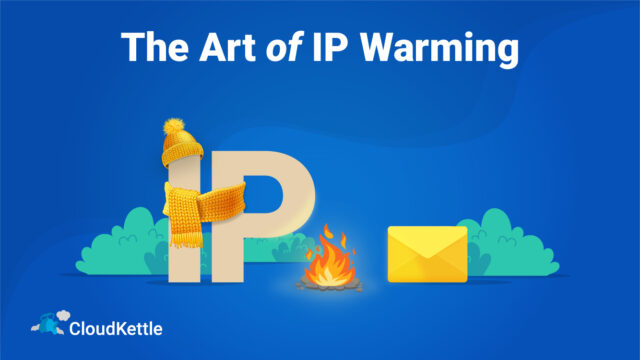So you have a marketing automation system and you are trying to make a big decision: dedicated IP or shared IP?
How do you know what will work best for you? What is the difference between a dedicated IP and a shared IP? What do you have to do to implement your own dedicated IP?
In this post, we’ll cover:
- What is an IP?
- How to decide between dedicated or shared IP
- Why do you need to warm your IP?
- IP Warming Best Practices
- Sample IP Warming Calendars
- Some important considerations
First let’s start with what an IP is. A sender IP address is the address from which emails are sent from a marketing automation system. Internet Service Providers (ISPs) will check the reputation via the send history, spam complaints and bounces to determine if the email is potentially spam, or if it can be safely delivered to the recipient’s inbox.
What is an IP?
A dedicated IP address is an IP address that is only being used by one website domain, and the sender is solely responsible for maintaining the reputation with ISPs. To maintain a positive or neutral reputation with ISPs in your dedicated IP, your monthly email send volume must be between 100,000 to 250,000. Sending less than 100,000 emails on a dedicated IP setup results in suboptimal delivery and can cause problems such as deferrals, bulk folder placement, or blocking of email messages. With a dedicated IP you have full control over your reputation and do not risk another company’s shady activity impacting your deliverability.
A shared IP address is shared with multiple website domains, and the reputation is shared with other domain owners to use it. Even though the email is from a shared IP, the ISPs would still validate SAP of the sender – including SPF, DMARC and DKIM records and these should be set up to improve deliverability and recognition. However, there are downsides to shared IPs, one of which is that another company using the IP may behave poorly, spoiling the quality of the IP for everyone. The opposite is also true, where you can benefit from the other domain’s good positive reputation of another domain – which is great if you are just starting out.
So how do you know which to choose?
The answer really comes down to the volume of emails you plan to send. If you are sending large volumes of emails per week, you can quickly build up your reputation without the help of other domains. You may also consider a dedicated IP if the shared IP you are using has a bad reputation. Lastly, budget is a factor. A shared IP is the more cost effective route, if you are trying to keep costs low.
If you decide to go the route of the dedicated IP, there is a process you will need to follow to get it up and running and ensure that your reputation is off to the best possible start. This process is called IP Warming.
Why warm your IP?
- ISPs are suspicious of mail from a new IP address with no recent history.
- Big consumer ISPs treat unknown sending IP addresses as though they have a negative-to-neutral sending reputation. You must build up a positive reputation over time.
- You must restrict volume day-per-day week-over-week to slowly build up volume and reputation.
- If you send too much, you get blocked or mail goes to the spam folder.
What are some IP warming best practices?
1. Don’t rush the warming process
2. Use subscriber segmentation to put your best foot forward with ISPs – Ideally you want to send your most engaged subscribers during warming
3. Send content with a strong Call-to-Action – ISPs want to see interaction with your email
4. Send at least three days a week
How long does the IP warming process take?
It takes 4-5 weeks (on average) to build up a good IP reputation. Sending too many emails out of the gate will negatively impact your reputation. Ideally, you should start with small segments per day on day 1, slowly building up over time and eventually doubling volume week over week. For any domain with at least 20,000 people, send no more than 20,000 messages to each ISP per day during week 1. Then double that daily volume week-by-week. Do this for any domain where you have more than 20,000 subscribers.
Domain/ISP based IP Address Warming Calendar
There are two types of IP warming practices: Per Domain and simplified. If you have the ability to segment your database by their ISP domain, it is recommended that you go this route. Break down your audiences into lists based on their domain, and ensure you follow this schedule:
| ISP/Domain | Day 1-3 | Day 4-5 | Day 6-7 | Day 8-14 | Day 15-21 | Day 22-28 | Day 29+ |
|---|---|---|---|---|---|---|---|
| AOL/Yahoo | 20,000 | 20,000 | 20,000 | 40,000 | 80,000 | 160,000 | 320,000 |
| Microsoft | 20,000 | 20,000 | 20,000 | 40,000 | 80,000 | 160,000 | 320,000 |
| Gmail | 5,000 | 10,000 | 20,000 | 40,000 | 80,000 | 160,000 | 320,000 |
| Spectrum/Charter | 20,000 | 20,000 | 20,000 | 40,000 | 80,000 | 160,000 | 320,000 |
| ATT | 20,000 | 20,000 | 20,000 | 40,000 | 80,000 | 160,000 | 320,000 |
| Cablevision | 20,000 | 20,000 | 20,000 | 40,000 | 80,000 | 160,000 | 320,000 |
| Comcast | 20,000 | 20,000 | 20,000 | 40,000 | 80,000 | 160,000 | 320,000 |
| Apple | 20,000 | 20,000 | 20,000 | 40,000 | 80,000 | 160,000 | 320,000 |
| All Others | 20,000 | 20,000 | 20,000 | 40,000 | 80,000 | 160,000 | 320,000 |
Simple IP Address Warming Calendar
If you do not have the ability to segment your database by domain, it is recommended that you follow a simplified warming calendar that increases the volume each week. This method is slower as it limits overall volume per IP address to help ensure it stays within the per-domain guidelines. A simplified schedule would look like:
| Max Daily Volume | Day |
|---|---|
| 50,000 | 1-7 |
| 100,000 | 8-14 |
| 200,000 | 15-21 |
| 400,000 | 22-28 |
| 800,000 | 29-35 |
| 1,600,000 | 36+ |
Some things to consider
Sending a steady volume Week-over-Week is best. It is recommended that you don’t send more than double volume week-over-week. If you normally send 100k/week and then suddenly send one large send to 25 million people, that “volume spike” will cause deliverability issues at ISPs. Do not use fake or test data. Emails must be sent to real recipients to positively contribute to your sending reputation. You do not need to send daily, but should send once per week.
To build and maintain a good sending reputation on a dedicated IP address, you must send at least 250,000 email messages per month. If you send less than 250,000 email messages per month, you are likely to have deliverability issues solely due to the low number of email messages being sent. In this scenario, you are likely better off sending from a shared IP address pool.
Who to email and what to send
In order to properly warm your IP, it is recommended that you target people in your database who are already engaged with your brand. People who have a high lead/person score, people who actively open and click on your emails, people with email addresses that do not bounce, and people who visit webpages, attend webinars and download content.
When sending emails, choose enticing subject lines that will encourage recipients to open the emails. Emails should have a strong call to action or bold offer that encourages people to interact with the email, and click through the links.
Summary (TL;DR)
To sum it up, a dedicated IP is ideal for larger companies who send a lot of emails, and are concerned about their sending reputation, whereas a shared IP may be more suitable for companies who are just starting out, need to build their reputation, and aren’t planning to send large volumes of email.
The IP warming process requires preplanning and consideration, and can take up to 5 weeks to complete the process. Recipients should already be engaged, and the emails should be of high value.
Are you interested in your own dedicated IP and want help with marketing automation, contact us for more information.



